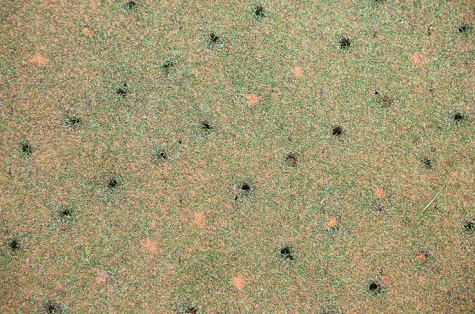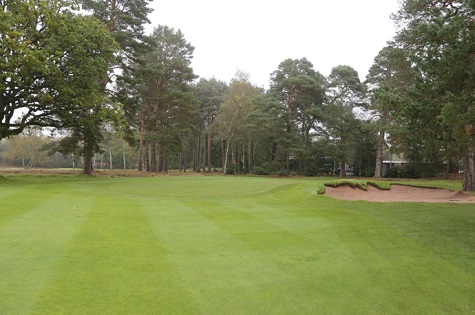Below is a fascinating brief on the management of golf courses, written by Dr Tim Lodge, who was asked by several golf clubs what they should consider doing during this unprecedented lockdown of golf courses.
The piece is written with safeguarding the fundamental agronomy requirements of the golf course in mind, while all care should of course be taken to observe the guidelines of the Sports governing bodies BIGGA / R&A - Laurence Gale, TurfPro editor.

Introduction
It is particularly ironic that this has suddenly become a very serious question facing all of the golf courses in the UK and probably the rest of the world. On how many advisory visits has it jokingly been said that looking after the golf course would be very easy were it not for the golfers! It would seem that the answer to this question is now fundamental to the survival of almost all courses if not of the game itself. Greenkeepers are a hardy lot however, and they are unlikely to abandon their profession because of a disease affecting mere mortals. So, I have decided to pen some initial thoughts on how the very many golfing businesses throughout the UK might ride out the current storm.
A fundamental component of the question is for how long the situation will in fact be necessary, something which is quite unknowable at the present time. I have therefore considered the situation in the face of 3 increasingly severe scenarios. These are golf ‘down-times’ of one month, three months and six months or longer starting from now, late March 2020. The intention is to identify the minimal maintenance requirements for golf courses that will allow the restoration of playing surfaces of suitable quality as quickly as possible when golfers are willing and able to play once again.
One month down-time
Starting from the rough and working through progressively diminishing mowing heights to the greens, maintenance policies in relation to the rough and semi-rough need not be altered during April. In practice, very little activity would normally be necessary here in any case. The abandonment of semi-rough mowing over this period is unlikely to have any detrimental consequences.
Anticipating a downtime of just 4 or 5 weeks through April is similarly unlikely to affect most fairways. Over this period the continuation of the established mowing regime, cutting as required between say 15 and 25 mm depending upon the circumstances (or more accurately on the sward composition) should be all that is required.
During April it is likely that a spring fertiliser would normally be applied to tees and this should go ahead as intended. Mowing weekly at 12 to 15 mm should be all that is required, preferably boxing off clippings unless this is not your normal policy.
On greens, there is no urgency to reduce the mowing height over this period and so the winter cut should be retained. Adequate control should be achievable mowing at 6 to 8 mm up to 3 times a week depending on how much growth takes place. Here again a spring fertiliser may well normally be applied and this should go ahead as intended. Irrigation is unlikely to be required and so there is no need to charge up the system in readiness for this.

Many golf courses might have been looking at this period with a view to undertaking a renovation or over-seeding operation. This down-time period may prove to be a very useful opportunity in these cases. Since playing quality in the immediate aftermath of the treatment would be less of a concern, scarification may be particularly brutal which would create space in the sward for successful new grass establishment following the incorporation of a copious quantity of seed. A generous application of top dressing would also be advantageous, though probably not essential.
Three months down-time
Over this period mowing frequencies generally may be relaxed. The management of fairways is very much dependent upon the general composition of the sward. Those dominated by perennial ryegrass, probably the majority of parkland courses, would require up to weekly or even fortnightly mowing at around 25 mm in order to maintain their quality beyond the down-time period. For fairways dominated by finer grasses, typically heathland and links courses, the comparatively elevated mowing height of 18 mm would be suitable. In these cases, growth will generally be slower and so even less frequent mowing may well be possible without detriment. The operation might be carried out when the sward reaches say 150 % of the mowing height.
It is unlikely any fairways will require fertiliser input under these circumstances. Indeed, such input is not normally to be recommended anyway. Although this down-time period will be extending into the summer months, irrigation should also be unnecessary mainly due to the relaxed mowing regime.

On tees it should only be necessary to continue the relaxed mowing regime described for the one month down-time period. Boxing off, if normally undertaken, should continue mainly to prevent weed ingress. Irrigation and further fertiliser applications should not be necessary. The opportunity might be taken at the height of the growing season, and assuming resources are available, to intensively hollow core tees, perhaps those on which levels in particular might be less than ideal. The cores may be allowed to dry at the surface before being broken up and matted back in. This operation would also be an excellent precursor for the incorporation of a generous quantity of suitable seed.
On greens, the extraordinarily policy of mowing at 8 to 10 mm just once or twice a week, boxing off of course, should be all that is required. There should be no necessity to irrigate or fertilise even on high sand content rootzones. Top dressing will also be unnecessary unless there is a particular intention to build up the sand content in the surface and sufficient resources are available to do this.
Six months or more down-time
The strategies adopted here become especially interesting because very far-reaching alterations in the nature of the various surfaces could be brought about. Significant improvements, most particularly in terms of sward composition, would be achievable.
It will continue to be necessary to mow fairways throughout the growing season, albeit under the relaxed regime described above. However, simply to walk away would result, in the majority of cases, in the development of meadows that would ultimately exhibit such a reduction in shoot density that extensive over-seeding would be essential. A significant time delay would therefore be experienced before suitable playing conditions could be restored.
The application of irrigation and fertiliser would be unnecessary. In the case of fescue/bent-dominated fairways the upshot would be the almost complete removal of any annual meadow grass. This would be a welcome outcome but, depending on how much was present previously, there may be a need to extensively over-seed simply to restore the areas of lost ground cover.
This downtime period would span all of the 2020 growing season. In this eventuality there would be no need to continue distinguishing tees from fairways in terms of their management. It would be appropriate, however, to adopt the policies described above for the one and three month periods before moving to the fairway regime.
In this particularly terrifying scenario, it will no doubt be essential to keep maintenance costs to the absolute minimum. To maintain anything resembling a golf green at the conclusion of this period however, some regular maintenance work will still need to be undertaken on an ongoing basis. I would recommend that weekly (or fortnightly, depending on the extent of growth taking place) mowing at between 10 and 12 mm should be undertaken, boxing off clippings as usual. No fertiliser or water need be applied, even on sand-based greens. Under this regime most annual meadow grass will die. On those lovely surfaces where this is considered a weed this will be a very desirable outcome. Unfortunately, this is not the case on the majority of greens. In most cases it will be necessary, therefore, to undertake an extensive over seeding operation. This should be preceded by a vigourous scarification to ready the surface and remove any dead grass. The work should be timed for the optimum period for grass seed establishment which is late July to mid August, depending how far north in the British Isles you are located. In Suffolk we would be looking at early August. In Aberdeen late July might be more appropriate. With the extremely relaxed mowing regime that will span the germination and establishment period, it will continue to be unnecessary to fertilise or irrigate following this treatment.
Concluding remarks

When the nightmare is eventually over, and golfers are able to return to the course it will be necessary to restore the playing quality of the surfaces. With careful planning those surfaces could very well be superior to those that exist at present. Reductions in mowing height must, however, be undertaken on a gradual basis reducing by no more than 25 % with each successive cut. Thus heights would need to drop from 12 to 8 mm, 8 to 5.5 mm, 5.5 to 4 mm in the case of greens for example. Reduction should only be undertaken if the overall health of the sward appears capable of accommodating it.
Every golf course is different and so none of these recommendations should be taken as gospel. We hope to be on hand to provide advice to all of the industry throughout this extremely challenging time. I wish you all the very best of luck during the months ahead.
Dr Tim Lodge
Agrostis Sports Surface Consulting
01359 259361
info@agrostis.co.uk